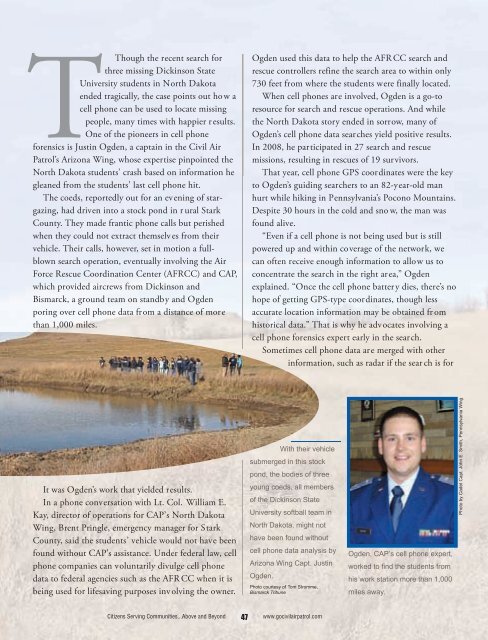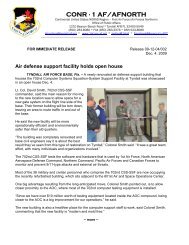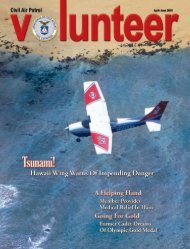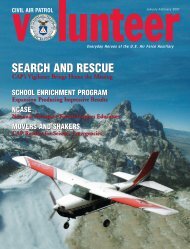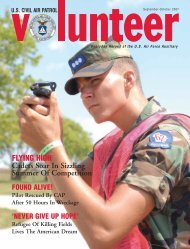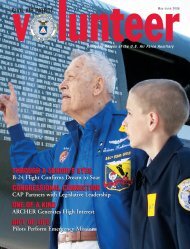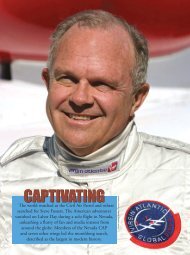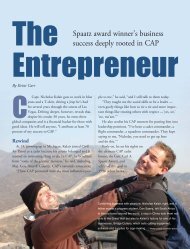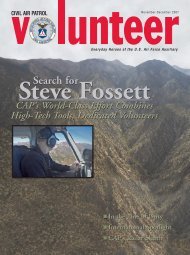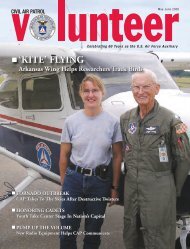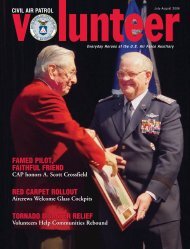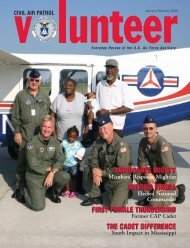’09 Conference Exceeds Expectations
Lo-res(4MB) - CAP VolunteerNow
Lo-res(4MB) - CAP VolunteerNow
- No tags were found...
Create successful ePaper yourself
Turn your PDF publications into a flip-book with our unique Google optimized e-Paper software.
TThough the recent search for<br />
three missing Dickinson State<br />
University students in North Dakota<br />
ended tragically, the case points out how a<br />
cell phone can be used to locate missing<br />
people, many times with happier results.<br />
One of the pioneers in cell phone<br />
forensics is Justin Ogden, a captain in the Civil Air<br />
Patrol’s Arizona Wing, whose expertise pinpointed the<br />
North Dakota students’ crash based on information he<br />
gleaned from the students’ last cell phone hit.<br />
The coeds, reportedly out for an evening of stargazing,<br />
had driven into a stock pond in r ural Stark<br />
County. They made frantic phone calls but perished<br />
when they could not extract themselves from their<br />
vehicle. Their calls, however, set in motion a fullblown<br />
search operation, eventually involving the Air<br />
Force Rescue Coordination Center (AFRCC) and CAP,<br />
which provided aircrews from Dickinson and<br />
Bismarck, a ground team on standby and Ogden<br />
poring over cell phone data from a distance of more<br />
than 1,000 miles.<br />
Ogden used this data to help the AFR CC search and<br />
rescue controllers refine the search area to within only<br />
730 feet from where the students were finally located.<br />
When cell phones are involved, Ogden is a go-to<br />
resource for search and rescue operations. And while<br />
the North Dakota story ended in sorrow, many of<br />
Ogden’s cell phone data searches yield positive results.<br />
In 2008, he participated in 27 search and rescue<br />
missions, resulting in rescues of 19 survivors.<br />
That year, cell phone GPS coordinates were the key<br />
to Ogden’s guiding searchers to an 82-year-old man<br />
hurt while hiking in Pennsylvania’s Pocono Mountains.<br />
Despite 30 hours in the cold and sno w, the man was<br />
found alive.<br />
“Even if a cell phone is not being used but is still<br />
powered up and within coverage of the network, we<br />
can often receive enough information to allow us to<br />
concentrate the search in the right area,” Ogden<br />
explained. “Once the cell phone battery dies, there’s no<br />
hope of getting GPS-type coordinates, though less<br />
accurate location information may be obtained fr om<br />
historical data.” That is why he advocates involving a<br />
cell phone forensics expert early in the search.<br />
Sometimes cell phone data are merged with other<br />
information, such as radar if the sear ch is for<br />
It was Ogden’s work that yielded results.<br />
In a phone conversation with Lt. Col. William E.<br />
Kay, director of operations for CAP’s North Dakota<br />
Wing, Brent Pringle, emergency manager for Stark<br />
County, said the students’ vehicle would not have been<br />
found without CAP’s assistance. Under federal law, cell<br />
phone companies can voluntarily divulge cell phone<br />
data to federal agencies such as the AFR CC when it is<br />
being used for lifesaving purposes involving the owner.<br />
With their vehicle<br />
submerged in this stock<br />
pond, the bodies of three<br />
young coeds, all members<br />
of the Dickinson State<br />
University softball team in<br />
North Dakota, might not<br />
have been found without<br />
cell phone data analysis by<br />
Arizona Wing Capt. Justin<br />
Ogden.<br />
Photo courtesy of Tom Stromme,<br />
Bismarck Tribune<br />
Ogden, CAPʼs cell phone expert,<br />
worked to find the students from<br />
his work station more than 1,000<br />
miles away.<br />
Photo by Cadet Capt. John E. Smith, Pennsylvania Wing<br />
Citizens Serving Communities...Above and Beyond<br />
47<br />
www.gocivilairpatrol.com


